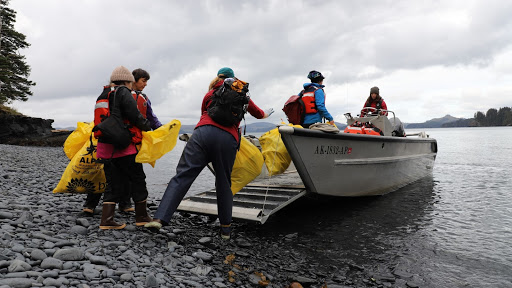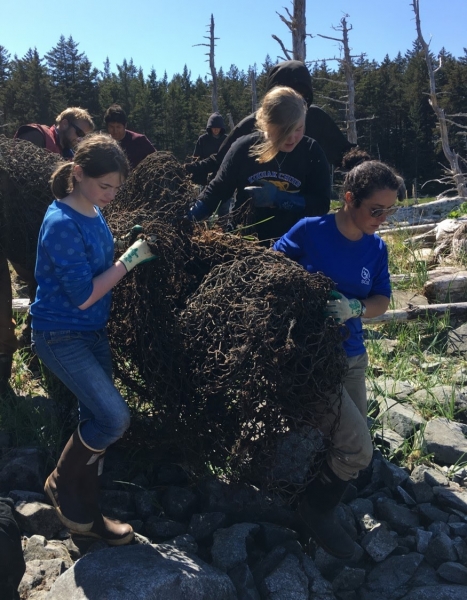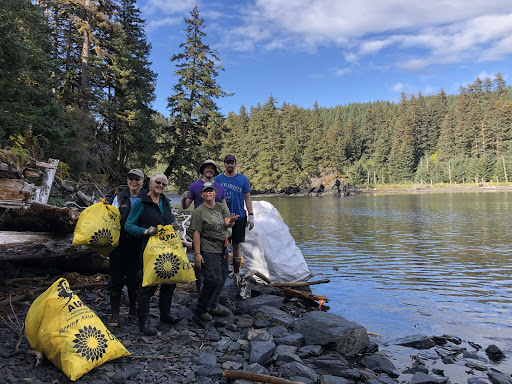During Whale Week (Feb. 10-14), NOAA’s Office of Response and Restoration is taking a closer look at the different pollutants affecting whales, and what OR&R and our partners are doing to help. With the support of a Fishing for Energy grant, a partnership between the National Fish and Wildlife Foundation, Covanta, and NOAA’s Marine Debris Program, the Island Trails Network is working to reduce entanglement and mortality of marine mammals, increasing awareness of the impact of entangling debris, and engaging volunteers to remove marine debris from coastlines. In this guest blog by Hana Bulow and Andy Schroeder from the Island Trails Network, learn more about the important work this nonprofit does and the positive impact they have on the Kodiak archipelago.

A group of wondrous islands are nestled in the Gulf of Alaska where the sea meets the snow-capped mountains along the southwestern coast of Alaska. This place, named the Kodiak archipelago, stretches 177 miles long and covers an area of 5,360 square miles. The Kodiak archipelago consists of 25 islands, some of which include Kodiak Island, Afognak, Shuyak, and the Trinity Islands. Kodiak Island is the largest of these, and the second largest island in the entire United States (the first being the Big Island of Hawaii). The Kodiak National Wildlife Refuge comprises two-thirds of Kodiak and was created in 1941 by President Franklin D. Roosevelt to protect Kodiak bears and their habitat.
Abundant wildlife thrive in the beautiful waters and landscapes of Kodiak. Many visitors and residents enjoy the remote wilderness year-round. Bear, deer, mountain goat, fox, eagle, and elk roam the mountains and hills. Harbor seals, Steller sea lions, sea otters, fish species, porpoises, orcas, sea birds, and whales fill the sea with life and wonder. Imagine if we could protect the ocean and its inhabitants just as we protect the land.
Yet this magical and remote northern island still faces the same threat as other parts of the globe. The common issue of marine pollution affects everything, everyone, and is everywhere. In particular, marine debris emerges even where there is minimal human activity. Ocean currents bring marine debris to Alaska from more densely populated areas, particularly Southeast Asia, according to a 2017 report from the Ocean Conservancy. With the help of a Fishing For Energy Removal Grant, a partnership between the National Fish and Wildlife Foundation, Covanta, and NOAA’s Marine Debris Program, Island Trails Network is working with volunteers to remove marine debris from the Kodiak coastlines.
Last year, our nonprofit removed over 20 tons of marine debris off the Kodiak shorelines. Most of the debris was collected in a 20-day period from remote locations on Shuyak and Afognak Islands. The entangling debris was the most difficult to remove, because it was usually intertwined in hefty driftwood, buried deep underground, or wrapped around boulders. The difficulty of the net removal opened the eyes of the volunteers to how marine animals suffer from these entangling debris.

If you were to take a long skiff ride on a fine Kodiak summer day, you could encounter as many as five species of whale (humpback, fin, minke, orca, and gray). Both entanglement and ingestion of marine debris can negatively impact marine mammals. Whale entanglement with net and line is a significant cause of death in marine mammals and poses a serious threat to the Gulf of Alaska ecosystem, and to ecosystems worldwide.
Whales are particularly at risk of entanglement from marine debris. A study of humpback whales in northern Southeast Alaska found that 71% of the observed whales had unambiguous scars due to entanglements in fishing gear (Neilson, 2009). NOAA Marine Mammal Biologist Ed Lyman, reported that he has seen no fewer than 20 humpback whales arrive in Hawaii entangled in fishing gear from Alaska. Observed impacts to the whales included lacerations from contact with rope, undernourishment, and exhaustion due to the heavy drag created by the entangling material during swimming and diving. (E. Lyman, pers. Communications).
In celebration of the return of Whale Fest Kodiak, we are partnering with the Ocean Plastics Recovery Project to conduct a marine debris cleanup near Kodiak April 20-May 1, 2020. To some, this may be a curious time to visit Alaska (spoiler alert — it won’t be summer yet!). But the dates are no accident — the cleanup is timed to occur during the migration of eastern North Pacific gray whales past Kodiak Island. For two five-day periods, this expedition will host volunteers from around the country for a remote cleanup on Afognak and Kodiak islands. While living aboard a contracted vessel, volunteers will go to beach sites for the removal of marine debris. Each workday is intense and challenging, yet incredibly rewarding as one can see the results of a cleaner coastline immediately.

Media coverage of marine debris and ocean plastics are at an all-time high. But today the coverage is more about problems than solutions. It’s easy to feel helpless in combating marine debris. At Island Trails Network, we believe the solution starts with talking about the issue, which then leads to awareness, compassion, and a heart-felt connection with our environment. This, in turn, may lead to action.
We invite you to take action with us. Click here to find out how to get involved.
Neilson, J.L., J.M. Straley, C.M. Gabriele, and S. hills. 2009. Non-lethal entanglement of humpback whales (Megapteranovaeangliae) in fishing gear in northern Southeast Alaska. Journal of Biogeography 36:452-464.
Stemming the Tide: Land-based Strategies for a Plastic-free Ocean. The Ocean Conservancy, 2017. www.oceanconservancy.org.
For more Whale Week blogs looking at the pollutants that threaten whales, and what NOAA and its partners is doing to help, visit our website.
